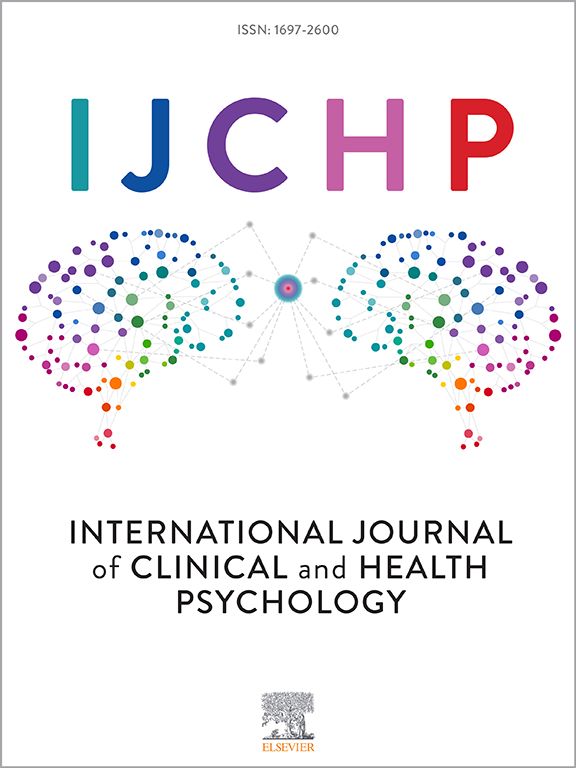Daily perceived stress and sexual health in couples with sexual interest/arousal disorder
IF 4.4
1区 心理学
Q1 PSYCHOLOGY, CLINICAL
International Journal of Clinical and Health Psychology
Pub Date : 2025-04-01
DOI:10.1016/j.ijchp.2025.100582
引用次数: 0
Abstract
Objective
Sexual Interest/Arousal Disorder (SIAD) is a common and distressing sexual health concern that may add stress to couple’s daily lives and maintain the low sexual desire/arousal. While stress has been linked to lower sexual desire, sexual satisfaction, and higher sexual distress in cross-sectional studies with community couples, dyadic research at the intersection of stress and sexual health is scarce. We examined the daily associations between perceived stress and sexual health among couples coping with SIAD.
Methods
Women and gender diverse individuals with SIAD, and their partners, (N = 229, Mage = 34.94) completed online validated measures of perceived stress, sexual desire, satisfaction, and distress for 56 days. Data were analyzed with residual dynamic structural equation modeling guided by the Actor-Partner Independence Model.
Results
On days when individuals with SIAD perceived more stress than usual, they and their partners reported lower sexual satisfaction and desire, and higher sexual distress. On days when partners perceived more stress, they and individuals with SIAD reported lower sexual satisfaction and desire, and partners also reported higher sexual distress. Between-person results across the diary period showed similar patterns, though fewer effects overall.
Conclusion
Findings highlight dyadic processes in sexual health whereby one partner’s daily stress was associated with lower sexual health for both partners. Stress might orient partners away from sensitive support provision and interfere with intimacy, which is crucial to sexual health. Interventions fostering sexual health in couples with SIAD should include a focus on stress management.
性兴趣/性唤起障碍夫妇的日常感知压力与性健康
目的性兴趣/觉醒障碍(SIAD)是一种常见的令人痛苦的性健康问题,它可能给夫妻的日常生活增加压力,并维持较低的性欲/觉醒。虽然在对社区夫妇的横断面研究中,压力与较低的性欲、性满意度和较高的性痛苦有关,但在压力和性健康交叉点的二元研究很少。我们研究了在SIAD夫妇中感知压力和性健康之间的日常联系。方法SIAD女性和不同性别的患者及其伴侣(N = 229,男= 34.94)在56天内完成了感知压力、性欲、满意度和痛苦的在线验证测量。采用基于行动者-伙伴独立模型的剩余动态结构方程模型对数据进行分析。结果当SIAD患者感受到比平时更多的压力时,他们和他们的伴侣报告的性满意度和性欲较低,性痛苦较高。在伴侣感受到更大压力的日子里,他们和SIAD患者报告的性满意度和性欲都较低,伴侣也报告了更高的性痛苦。在日记期间,人与人之间的结果也显示出类似的模式,尽管总体上影响较小。结论:研究结果强调了性健康的二元过程,其中一方的日常压力与双方的性健康较低有关。压力可能会使伴侣远离敏感的支持,并干扰对性健康至关重要的亲密关系。促进SIAD夫妇性健康的干预措施应包括注重压力管理。
本文章由计算机程序翻译,如有差异,请以英文原文为准。
求助全文
约1分钟内获得全文
求助全文
来源期刊

International Journal of Clinical and Health Psychology
PSYCHOLOGY, CLINICAL-
CiteScore
10.70
自引率
5.70%
发文量
38
审稿时长
33 days
期刊介绍:
The International Journal of Clinical and Health Psychology is dedicated to publishing manuscripts with a strong emphasis on both basic and applied research, encompassing experimental, clinical, and theoretical contributions that advance the fields of Clinical and Health Psychology. With a focus on four core domains—clinical psychology and psychotherapy, psychopathology, health psychology, and clinical neurosciences—the IJCHP seeks to provide a comprehensive platform for scholarly discourse and innovation. The journal accepts Original Articles (empirical studies) and Review Articles. Manuscripts submitted to IJCHP should be original and not previously published or under consideration elsewhere. All signing authors must unanimously agree on the submitted version of the manuscript. By submitting their work, authors agree to transfer their copyrights to the Journal for the duration of the editorial process.
 求助内容:
求助内容: 应助结果提醒方式:
应助结果提醒方式:


